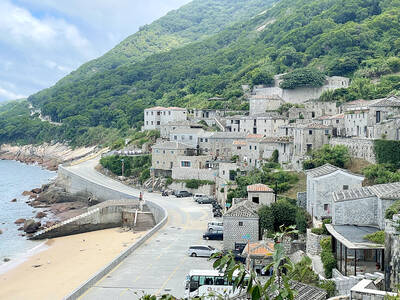Automatic translation kiosks are being installed at tourist destinations to help lower communication barriers for visitors, the Tourism Administration said on Tuesday.
With 12 million international visitors expected next year, the agency said it is hoping to enhance foreign-language services at airports and scenic areas.
Information counters are currently staffed by people who speak different languages, but the service is limited by working hours, it said in a news release.

Photo courtesy of the Tourism Administration
The agency is therefore installing “smart counters” powered by artificial intelligence (AI), which can provide real-time translations for English, Japanese and Korean speakers, it said.
The kiosks are able to help travelers and staff communicate, while also exhibiting Taiwan’s technological prowess, it said.
The AI used to power the kiosks is comparable to a professional interpreter with three years of experience, the agency said, adding that they also utilize transparent screens and 5G for a seamless face-to-face interaction.
Kiosks have already been set up at information desks at Taipei International Airport (Songshan airport) and the visitors’ center at Yehliu Geopark (野柳地質公園) in New Taipei City, it said.
If it receives positive feedback, the agency said it plans to eventually provide the service at airports nationwide and the 13 scenic areas under its jurisdiction.
Additional languages are to be added in the future depending on database availability, Information Management Office Director Liu Chao-jung (劉昭榮) said.

The first two F-16V Bock 70 jets purchased from the US are expected to arrive in Taiwan around Double Ten National Day, which is on Oct. 10, a military source said yesterday. Of the 66 F-16V Block 70 jets purchased from the US, the first completed production in March, the source said, adding that since then three jets have been produced per month. Although there were reports of engine defects, the issue has been resolved, they said. After the jets arrive in Taiwan, they must first pass testing by the air force before they would officially become Taiwan’s property, they said. The air force

GLOBAL: Although Matsu has limited capacity for large numbers of domestic tourists, it would be a great high-end destination for international travelers, an official said Lienchiang County’s (Matsu) unique landscape and Cold War history give it great potential to be marketed as a destination for international travelers, Tourism Administration Director General Chen Yu-hsiu (陳玉秀) said at the weekend. Tourism officials traveled to the outlying island for the Matsu Biennial, an art festival that started on Friday to celebrate Matsu’s culture, history and landscape. Travelers to Matsu, which lies about 190km northwest of Taipei, must fly or take the state-run New Taima passenger ship. However, flights are often canceled during fog season from April to June. Chen spoke about her vision to promote Matsu as a tourist attraction in

PAWSITIVE IMPACT: A shop owner said that while he adopted cats to take care of rodents, they have also attracted younger visitors who also buy his dried goods In Taipei’s Dadaocheng (大稻埕), cats lounging in shops along Dihua Street do more than nap amid the scent of dried seafood. Many have become beloved fixtures who double as photography models, attracting visitors and helping boost sales in one of the capital’s most historic quarters. A recent photo contest featuring more than a dozen shop cats drew more than 2,200 submissions, turning everyday cat-spotting into a friendly competition that attracted amateur and professional photographers. “It’s rare to see cats standing, so when it suddenly did, it felt like a lucky cat,” said Sabrina Hsu (徐淳蔚), who won the NT$10,000 top prize in

STRIKE: Some travel agencies in Taiwan said that they were aware of the situation in South Korea, and that group tours to the country were proceeding as planned A planned strike by airport personnel in South Korea has not affected group tours to the country from Taiwan, travel agencies said yesterday. They added that they were closely monitoring the situation. Personnel at 15 airports, including Seoul’s Incheon and Gimpo airports, are to go on strike. They announced at a news conference on Tuesday that the strike would begin on Friday next week and continue until the Mid-Autumn Festival next month. Some travel agencies in Taiwan, including Cola Tour, Lion Travel, SET Tour and ezTravel, said that they were aware of the situation in South Korea, and that group